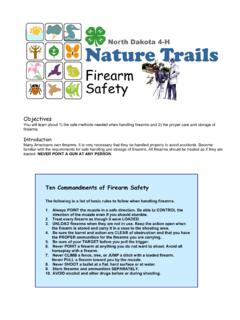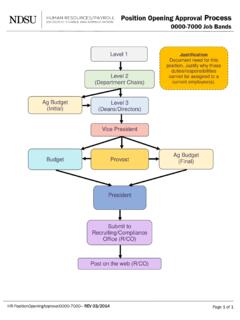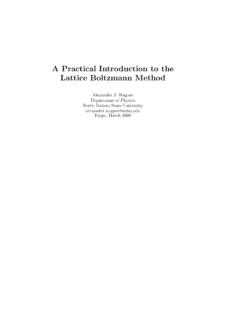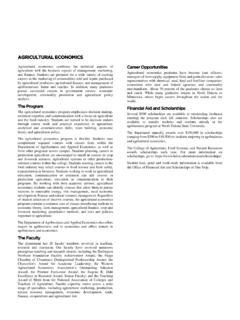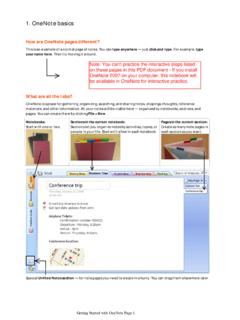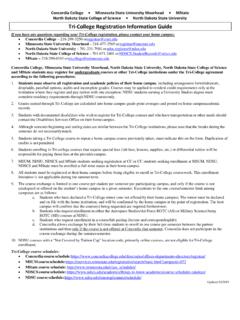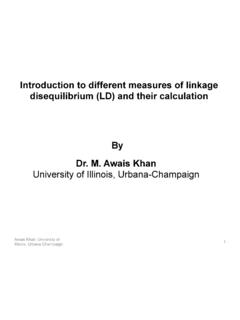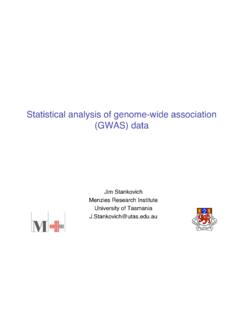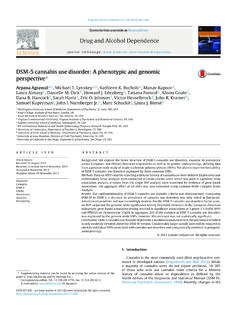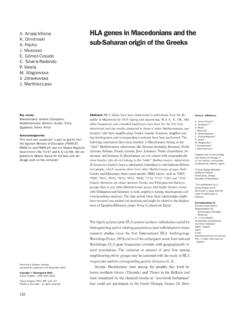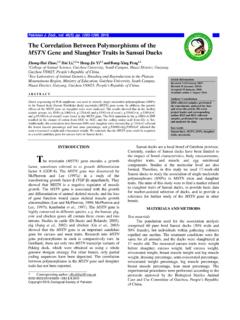Transcription of Status and Prospects of Association Mapping in …
1 THE PLANT GENOME JULY 2008 VOL. 1, NO. 1 5 REVIEW & INTERPRETATIONS tatus and Prospects of Association Mapping in PlantsChengsong Zhu, Michael Gore, Edward S. Buckler, and Jianming Yu*AbstractThere is tremendous interest in using Association Mapping to identify genes responsible for quantitative variation of complex traits with agricultural and evolutionary importance. Recent advances in genomic technology, impetus to exploit natural diversity, and development of robust statistical analysis methods make Association Mapping appealing and affordable to plant research programs. Association Mapping identifi es quantitative trait loci (QTLs) by examining the marker-trait associations that can be attributed to the strength of linkage disequilibrium between markers and functional polymorphisms across a set of diverse germplasm.
2 General understanding of Association Mapping has increased signifi cantly since its debut in plants. We have seen a more concerted effort in assembling various Association - Mapping populations and initiating experiments through either candidate-gene or genome-wide approaches in different plant species. In this review, we describe the current Status of Association Mapping in plants and outline opportunities and challenges in complex trait dissection and genomics-assisted crop genome-wide Association analyses of major human diseases have yielded very promising results, corroborating fi ndings of previous candidate-gene Association studies and identifying novel disease loci that were previously unknown (Th e Wellcome Trust Case Control Consortium, 2007).
3 Th e same strategy is being exploited in many plant species thanks to the dramatic reduction in costs of genomic technologies. In contrast to the widely used linkage analysis traditional map-ping research in plants, Association Mapping searches for functional variation in a much broader germplasm context. Association Mapping enables researchers to use modern genomic technologies to exploit natural diver-sity, the wealth of which is known to plant geneticists and breeders but has been utilized only on a small scale before the genomics era. Owing to the ease of producing large numbers of progenies from controlled crosses and conducting replicated trials with immortal individuals (inbreds and recombinant inbred lines, RILs), associa-tion Mapping in plants may prove to be more promising than in human or animal genetics.
4 In the current review, Published in The Plant Genome 1:5 20. Published 16 July : Crop Science Society of America677 S. Segoe Rd., Madison, WI 53711 USAAn open-access publicationAll rights reserved. No part of this periodical may be reproduced or transmitted in any form or by any means, electronic or mechanical, including photocopying, recording, or any information storage and retrieval system, without permission in writing from the publisher. Permission for printing and for reprinting the material contained herein has been obtained by the Zhu and J. Yu, Dep. of Agronomy, Kansas State University, 2004 Throckmorton Hall, Manhattan, KS 66506; M. Gore, Dep. of Plant Breeding and Genetics, Cornell University, Ithaca, NY 14853; Edward S.
5 Buckler, USDA-ARS and Institute for Genomic Diversity, Cornell University, Ithaca, NY 14853. Mention of trade names or commercial products in this publication is solely for the purpose of providing specifi c information and does not imply recommendation or endorsement by the USDA. Received 11 Feb. 2008. *Corresponding author AB-QTL, advanced backcross QTL;AFLP, amplifi ed fragment length polymorphism; GC, genomic control; IL, introgression library; K, kinship matrix; lcyE, lycopene epsilon cyclase; LD, linkage disequilibrium; NAM, nested Association Mapping ; oligo, oligonucleotide; PCA, principal component analysis; Q, population structure; QTDT, quantitative transmission disequilibrium test; QTLs, quantitative trait loci; RAPD, random amplifi ed polymorphic DNA; RILs, recombinant inbred lines; SA, structured Association ; SBE, single base extension; SFP, single feature polymorphism; SNPs, single nucleotide polymorphisms; SSRs, simple sequence THE PLANT GENOME JULY 2008 VOL.
6 1, NO. 1we focus on presenting Association Mapping as a new strategy for genetic dissection of complex traits, steps to initiate an Association Mapping study, and common methods in genotyping, phenotyping, and data analysis. Interested readers may also refer to previous reviews on other technical aspects such as linkage disequilibrium, population structure, and statistical analysis (Ersoz et al., 2008; Flint-Garcia et al., 2003; Yu and Buckler, 2006).WHY Association Mapping ?New ToolTh e phenotypic variation of many complex traits of agri-cultural or evolutionary importance is infl uenced by multiple quantitative trait loci (QTLs), their interaction, the environment, and the interaction between QTL and environment.
7 Linkage analysis and Association Mapping are the two most commonly used tools for dissecting complex traits (Fig. 1). Linkage analysis in plants typi-cally localizes QTLs to 10 to 20 cM intervals because of the limited number of recombination events that occur during the construction of Mapping populations and the cost for propagating and evaluating a large number of lines (Doerge, 2002; Holland, 2007). While hundreds of linkage analysis studies have been conducted in various plant species over the past two decades (Holland, 2007; Kearsey and Farquhar, 1998), only a limited number of identifi ed QTLs were cloned or tagged at the gene level (Price, 2006). Association Mapping , also known as link-age disequilibrium (LD) Mapping , has emerged as a tool to resolve complex trait variation down to the sequence level by exploiting historical and evolutionary recombination events at the population level (Nordborg and Tavare, 2002; Risch and Merikangas, 1996).
8 As a new alternative to tra-ditional linkage analysis, Association Mapping off ers three advantages, (i) increased Mapping resolution, (ii) reduced research time, and (iii) greater allele number (Yu and Buckler, 2006). Since its introduction to plants (Th orns-berry et al., 2001), Association Mapping has continued to gain favorability in genetic research because of advances in high throughput genomic technologies, interests in iden-tifying novel and superior alleles, and improvements in statistical methods (Fig. 2).Based on the scale and focus of a particular study, Association Mapping generally falls into two broad cat-egories (Fig. 3), (i) candidate-gene Association Mapping , which relates polymorphisms in selected candidate genes that have purported roles in controlling phenotypic vari-ation for specifi c traits; and (ii) genome-wide Association Mapping , or genome scan, which surveys genetic varia-tion in the whole genome to fi nd signals of Association for various complex traits (Risch and Merikangas, 1996).
9 While researchers interested in a specifi c trait or a suite of traits oft en exploit candidate-gene Association map-ping, a large consortium of researchers might choose to conduct comprehensive genome-wide analyses of various Figure 1. Schematic comparison of linkage analysis with designed Mapping populations and Association Mapping with diverse ET AL.: Association Mapping IN PLANTS 7traits by testing hundreds of thousands of molecular markers distributed across the genome for TechnologyAdvances in high-throughput genotyping and sequenc-ing technologies have markedly reduced the cost per data point of molecular markers, particularly single nucle-otide polymorphisms (SNPs) (Hirschhorn and Daly, 2005; Syvanen, 2005).
10 For candidate-gene Association Mapping , information regarding the location and func-tion of genes involved in either biochemical or regula-tory pathways that lead to fi nal trait variation oft en is required. Fortunately, due to the availability of annotated genome sequences from several model species and the general application of genomic technology ( , sequenc-ing, genotyping, gene expression profi ling, comparative genomics, bioinformatics, linkage analysis, mutagen-esis, and biochemistry), a whole host of candidate gene sequences for various complex traits is now available for further Association analysis. On the other hand, as it becomes aff ordable to identify hundreds of thousands of SNPs through resequencing a core set of diverse lines and genotype these SNPs across a larger number of samples, researchers are moving toward genome-wide Association analyses of complex traits.
